What to expect from the new Xeon E. Compare with E3 and draw conclusions

I continue to test processors. This time, my attention completely switched from desktop Core to server Xeon. That, I must admit, is not accidental. First, I was warmly asked about this in the comments to the previous article , and secondly, our park was replenished with fresh Xeon E - we decided to update the line of single-processor dedicated servers and bought E-2134 and E-2136 as an alternative to E3-12XX.
Initially, I had Napoleonic plans. Since our “collection” Xeon E3-12xyVz, where “z” takes a value from 2 to 6, covers processors from Ivy Bridge to Kaby Lake, it was interesting for me to compare them with each other and with the new Xeon E family.
')
But having estimated the amount of work to be done, I decided to lower the degree of ambition and leave only two previous families from the representatives of Xeon E3: Xeon E3-12xxV5 and Xeon E3-12xxV6. Together with the new Xeon E, all three families are actually built on one architecture, one process technology and, thanks to Intel, one FCLGA1151 processor socket.
Moreover! There were processors from the two previous families intersecting along the base frequency and frequency in a “boost”, which, in my opinion, is a great success :) In the comments to the previous article there was a request from readers to compare different families on the same frequency to see a clean increase in microarchitectural changes. The idea seemed interesting to me, and maybe someday I will return to Core to bring it to life. In the meantime, I decided to adapt to what is at hand, and see how the Xeon will behave with the same frequencies.
Testing
Eight processors from three families are involved in testing:
Skylake - Intel E3-1230v5, E3-1240v5, E3-1270v5,
Kaby Lake - E3-1230v6, E3-1240v6, E3-1270v6,
Coffee Lake - E-2134 and E-2136.
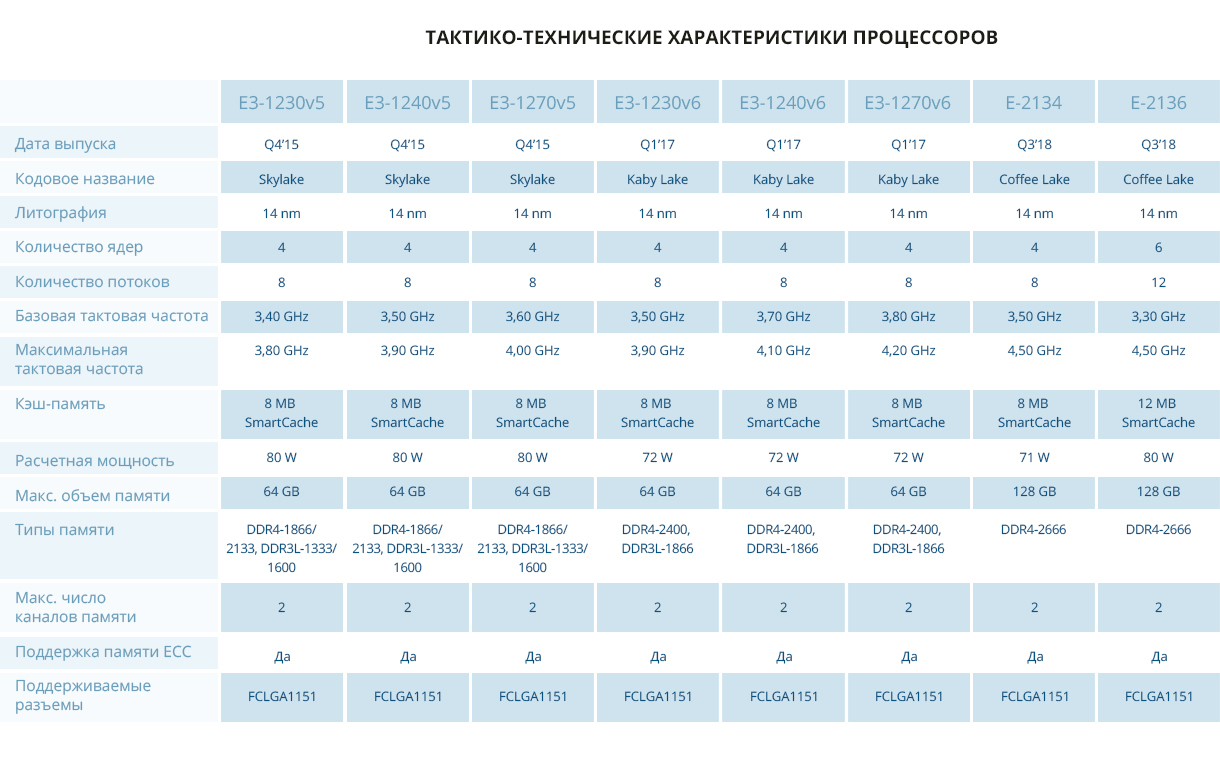
Performance characteristics of platforms
Servers with Intel E3-1230v5, E3-1240v5, E3-1270v5, E3-1230v6, E3-1240v6, and E3-1270v6 processors have the same basic configuration:
- Motherboard: Supermicro X11SSE-F (2.2 BIOS).
- RAM: 16 GB Micron Technology (DDR4-2666) ECC - 2 pieces.
- SSD: Intel DC S4500 480 GB - 2 pieces in RAID1.
Servers with Intel E-2134 and E-2136 processors also work on the same platform:
- Motherboard: Supermicro X11SCE-F (BIOS 1.0a).
- RAM: 16 GB Micron Technology (DDR4-2666) ECC - 2 pieces.
- SSD: Intel DC S4500 480 GB - 2 pieces in RAID1.
Software: OS CentOS Linux 7 x86_64 (7.6.1810)
Kernel: 3.10.0-957.5.1.el7.x86_64
The optimizations made relative to the standard installation: kernel launch options added elevator = noop selinux = 0.
Testing is done with all the patches for Specter, Meltdown and Foreshadow vulnerabilities that are backported to this kernel.
Tests used for the study:
- Sysbench
- Geekbench
- Phoronix test suite
A more detailed description of the tests can be found in the previous article . He took the same set plus Timed GCC Compilation, which he added at the request of readers. In the meantime, briefly about what and how to measure.
Sysbench test
Multi-threaded test, in all cores. I measured one indicator - CPU speed events per second, which means the number of operations performed by the processor per second - the higher the value, the more productive the system.
Geekbench test
Measured two main indicators based on the results of several tests: Single-Core Score and Multi-Core Score, - single and multi-threaded tests. Units of measurement - abstract "parrots". The more “parrots”, the better.
Phoronix Test Suite
He took only 10 from the big set - the same as last time - and to them, as I said above, added Timed GCC Compilation. The result was 8 multi-threaded tests and 2 single-threaded (Himeno and LAME MP3 Encoding).
In these tests, the higher the score, the better.
- Test John the Ripper for password selection. Take the Blowfish cryptographic algorithm.
- The Himeno test is a Poisson linear pressure solver using the Jacobi point method.
- 7-Zip Compression - 7-Zip test using p7zip with an integrated performance test feature.
- OpenSSL is a set of tools that implement the SSL (Secure Sockets Layer) and TLS (Transport Layer Security) protocols. Measures the performance of RSA 4096-bit OpenSSL.
- Apache Benchmark - measures how many requests per second a given system can withstand when executing 1,000,000 requests, while 100 requests are executed simultaneously. Units are requests per second.
And in these if less, it is better - in all tests measured by its time.
- C-Ray tests CPU performance on floating-point calculations. This is a multi-threaded test (16 threads per core).
- Parallel BZIP2 Compression - measures file compression time (.tar package of the Linux kernel source) using BZIP2 compression.
- The LAME MP3 Encoding test runs as one stream.
- Test ffmpeg x264 - multi-threaded.
- Timed GCC Compilation. In my first article in the comments, readers asked to add a test related to compiling from source. This test is for you :-) It shows how long the GNU GCC compiler build (version 8.2.0) takes. Units are seconds.
So, I gathered on one test stand representatives of three families - Skylake, Kaby Lake and Coffee Lake. All processors, except for the new E-2136, have four cores and eight threads in HT, as well as the same total amount of cache memory. All processors have dual-channel memory with ECC support and close base frequencies. As in the previous article, I note that the processors of three different families are built on the same architecture. Accordingly, "the frequencies, cores and threads should rule the ball."
But this time it will be even more interesting: all these families have different supported frequencies when working with RAM - 2133, 2400 and 2666, respectively, as well as a different thermal pack. It is curious to see how this will affect the test results and whether it will affect at all. Of course, I assume that the higher the frequency of working with RAM, the better the processor will pass the tests.
Of particular interest are the E3-1240v5 and E3-1230v6 with the same frequencies: the base 3.50 GHz and 3.90 GHz in Turbobust. I suppose that they should show identical or similar results, since they differ only in thermal pack and memory frequency.
As for my predictions about Xeon E, I think that the results of single-flow tests of E-2134 and E-2136 should also be the same or very close in terms of performance - although the base frequency is different, but the frequencies in the “boost” are the same. And of course, the results of both Xeon E, I am sure, will be better than their predecessors: 4.5 GHz at maximum speeds and 6 cores in E-2136 will definitely show themselves. And now, "we will see" as far as I am right.
Test results
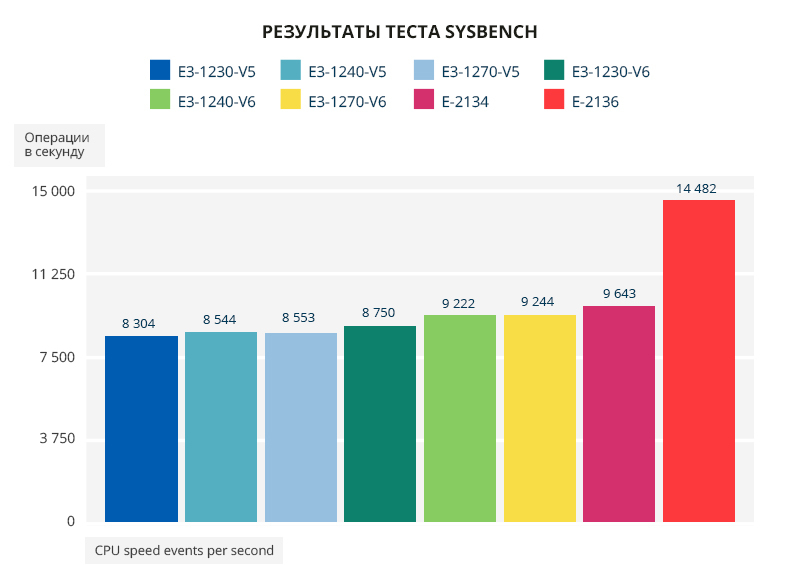
In the test Sysbench E3-1240v5 and E3-1270v5 go flush. With E3-1230v6 growth begins, which ends with a sharp rise of the E-2136. E-2136 is 36% better in this test than the E3-1270v6, and 43% better than the E3-1230v5. E-2134 is only 4% ahead of E3-1270v6 and 14% E3-1230v5. The difference between E3-1240v5 and E3-1230v6 is 2.4% in favor of E3-1230v6.
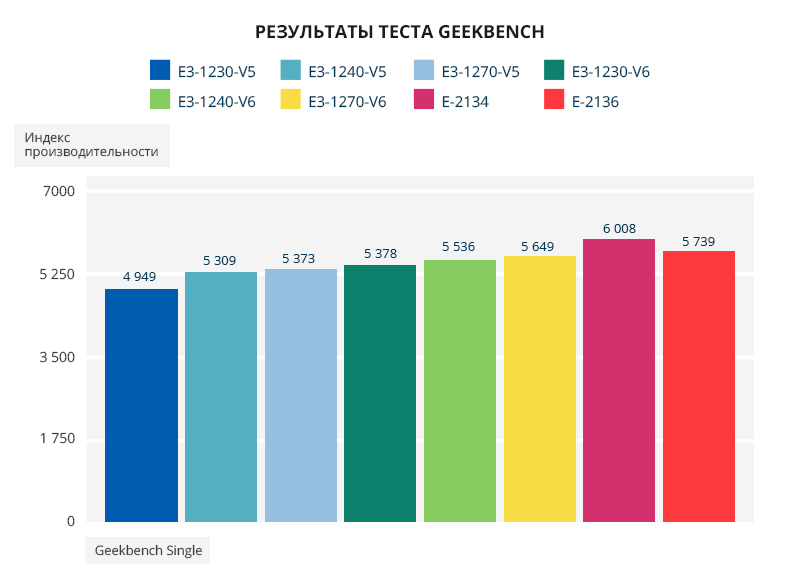
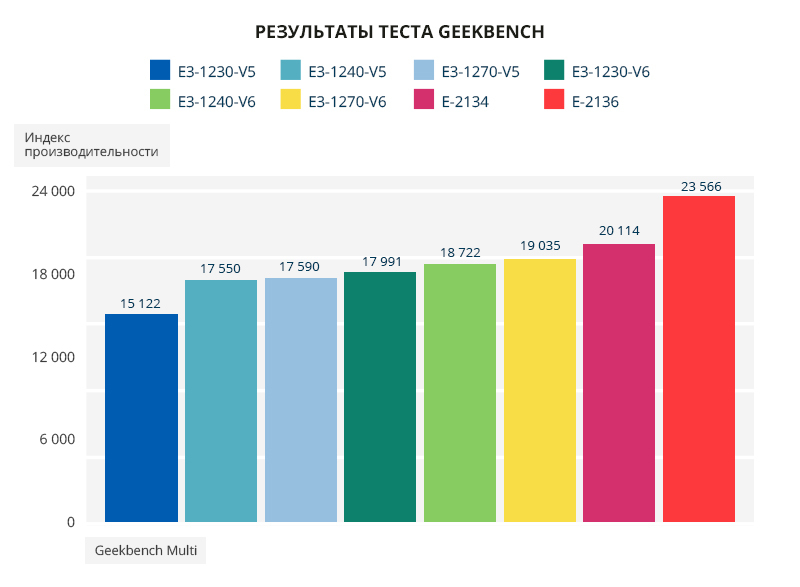
In the Geekbench single-threaded test, growth is observed within each family, with the exception of the Xeon E family: E-2134 outperforms E-2136 by 4.5%.
In a multi-threaded test, the growth trend persists in all three families: E-2136 is 14.6% ahead of E-2134. In the single-threaded test, the E3-1240v5, E3-1270v5 and E3-1230v6 go flush, and in the multi-threaded E3-1230v6 it overtakes the E3-1240v5 by 2.5%
Links to Geekbench test results:
Xeon E3-1230v5
Xeon E3-1240v5
Xeon E3-1270v5
Xeon E3-1230v6
Xeon E3-1240v6
Xeon E3-1270v6
Xeon E-2134
Xeon E-2136

The results of the multi-threading John The Ripper are very similar to the Sysbench test results: E3-1240v5, E3-1270v5 and E3-1230v6 give almost the same performance and the E-2136 is 33% faster than the E-2134. Clearly visible is a steady increase in performance E3-1240v6, E3-1270v6 and the transition to the next generation - E-2134.
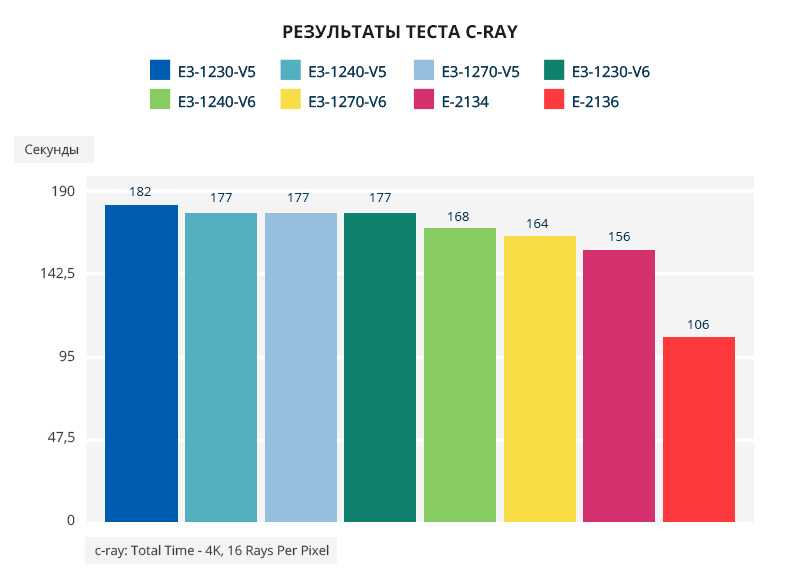
In the C-ray test, the highest result is at E-2136, the lowest - at E3-1230v5, which is quite logical chronologically. Second place in the new E-2134. But the E3-1240v5, E3-1270v5 and E3-1230v6 again go flush.
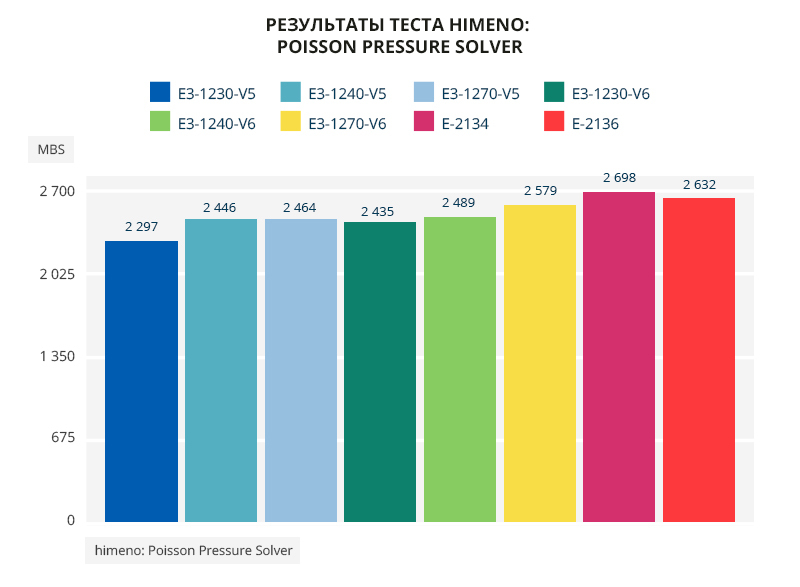
The Himeno single-threaded test almost exactly repeats the results of the Geekbench single-threaded test: there is an increase within each family, with the exception of Xeon E: E-2134 overtakes E-2136 by 2.4%. The difference between E3-1240v5, E3-1270v5 and E3-1230v6 at the level of error.

In the 7zip test we observe a beautiful “ladder” and growth in all families. The difference between E3-1240v5, E3-1270v5 at the level of error. E3-1230v6 almost 4% better passes this test than the E3-1240v5. E-2134 is 21% ahead of E3-1230v5, 16% ahead of E3-1270v5 and 6.6% ahead of E3-1270v6. And E-2136 is the best :-)
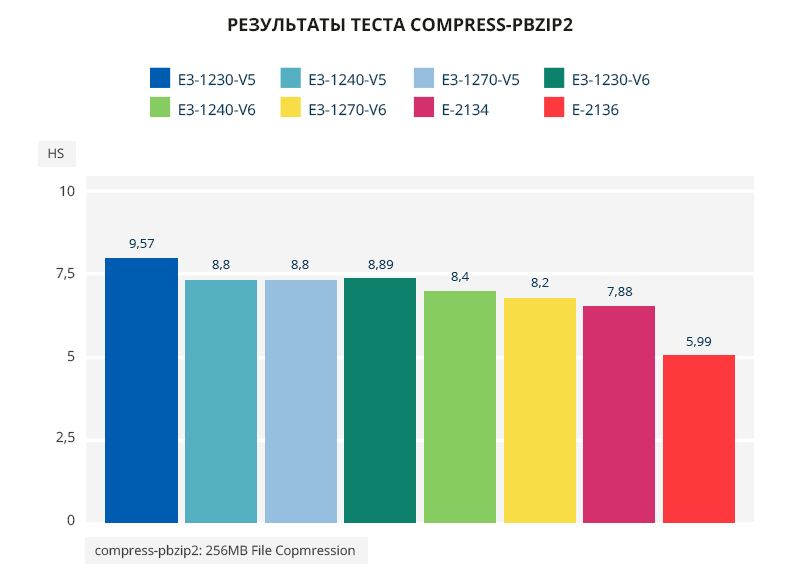
A similar trend is observed in the pbzip2 test, only E3-1230v6 is knocked out.

I would like to say that the mp3 test shows a uniform “ladder down”, but the difference even between the extreme ones in the E3-1230v5 and E-2136 graphics is only 9.5%, so calling it “ladder” is not very correct. Especially because the E3-1230v6 introduces its own corrections, and the E3-1240v5 and E3-1270v5 only add graphics to the slope.
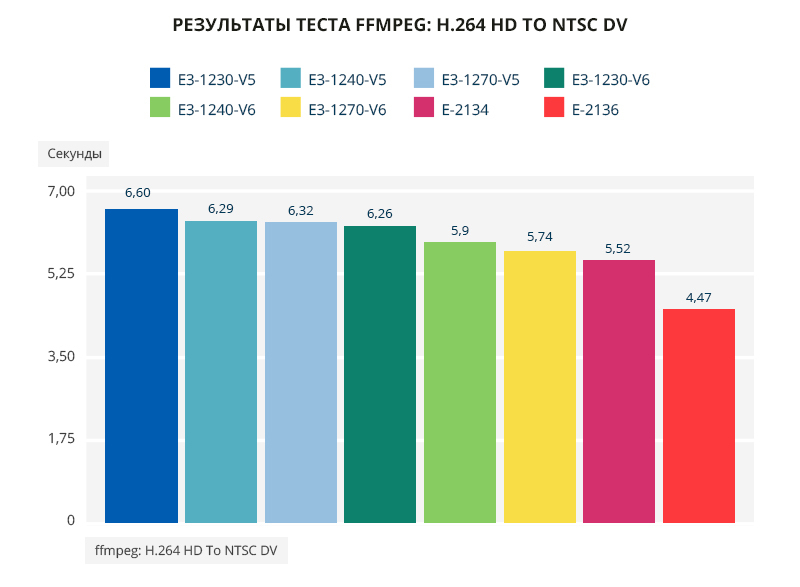
In the multithreaded dough ffmpeg “stairs down” already without bursts and with an almost level ground around E3-1240v5, E3-1270v5 and E3-1230v6. E-2136 in this test is better than E-2134 by 19%, E3-1230v5 by 32%, E3-1270v5 by 29% and E3-1270v6 by 22%.
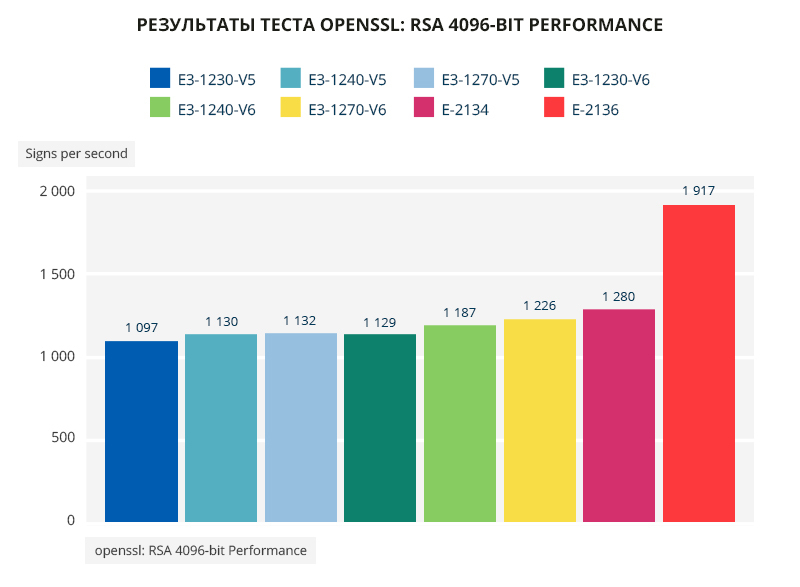
The OpenSSL test shows a “ladder up” with a platform at E3-1240v5, E3-1270v5, E3-1230v6 and a noticeable margin at E-2136. E-2134 is 14% better than the E3-1230v5.
The E-2136 is 43% ahead of the E3-1230v5, 36% ahead of the E3-1270v6 and 33% ahead of the E-2134.
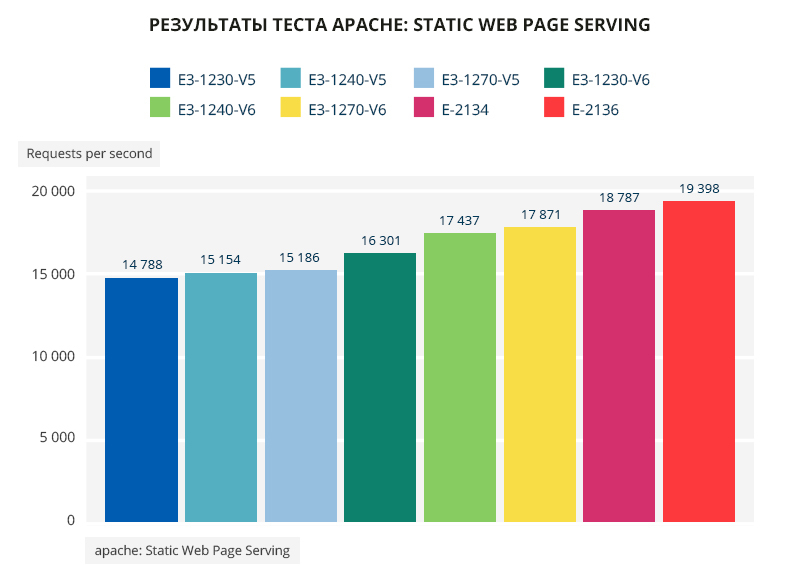
In the Apache test, the difference between the V5 family of processors is minimal. In the V6 family, the “ladder up”: E3-1270v6 is 8.8% better than the E3-1230v6. The Xeon E family continues the growth trend and adds “steps”: E-2136 is 3% ahead of E-2134, 8% ahead of E3-1270v6 and 22% ahead of E3-1270v5. The difference between the first V5 representative and the new E-2136 is 24%. E3-1240v5 and E3-1270v5 at the level of error. A noticeable jump in the transition from the V5 family to the V6: the difference between the E3-1230v6 and the E3-1240v5 is 7%.

In the GCC compile time test, the last place is at E3-1230v5, the second last place is shared between E3-1240v5 and E3-1270v5. The victory remains for the six-core E-2136.

If in the previous article, where I tested Core , I wrote that I was not surprised by the results - they were predictable, but this time I was not surprised :-)
But first, a little background.
I must say that all the tests for the E3-1230v6 I had to redo. And all because of the fact that the first time I made a mistake - a representative from the V6 family passed the test site with RAM in single-channel mode. As a result, the nested index in the Geekbench - Memory Score test turned out to be lower than that of the E3-1240v5, which greatly influenced the overall result of the entire test. E3-1240v5 in terms of performance significantly overtook E3-1230v6.
A similar picture was drawn in all single-threaded tests. He wrinkled his brain for a long time to give at least some intelligible explanation of the current situation (and even found it!), Until he rubbed his eyes and redid all the tests, but already with dual-channel memory. And now to the conclusions.
Expectations vs reality
The first thing I expected to see is the same performance for the E3-1240v5 and E3-1230v6. And saw. In all tests except mp3 and pbzip2, E3-1230v6 is better or equal to E3-1240v5. Personally, I do not think that this is a pure increase in micro-architecture. Most likely, this result is obtained due to the higher clock frequency of the RAM. One thing I can say for sure: memory in one channel has a significant effect on test results, so be careful :)
My second hypothesis concerned two representatives of the V5 family - E3-1240v5 and E3-1270v5. Honestly, I hoped to find at least a small difference between them, but according to the results of the test, it turned out to be nothing from the word at all. The effect of an additional 100 MHz has to be looked under a microscope in the vast majority of tests.
At the same time, the same 100 MHz are quite visible with the naked eye when comparing the E3-1270v5 and E3-1240v6. I suppose, again, affect the memory frequency.
Moving on to fresh Xeon E. I was completely unprepared for the fact that in single-threaded tests, E-2136 would be inferior to E-2134. Although the base frequency of the older model is lower by 200 MHz, but the frequency in the “boost” is the same. I repeated each test several times with each processor in order to get the result I expected, but I could not achieve it :) I really don’t like to draw conclusions and conclusions, so I’d love to know the opinions of the esteemed readers: what could be so unusual about results?
That's where expectations coincided with reality, so this is when comparing the new Xeon E family with its predecessors - here the predictions that the new Es will bypass the good old E3 were just confirmed by tests. And if the quad-core E-2134 does this at the expense of a higher frequency in the “boost,” then the E-2136 comes off even more at the expense of its honest six cores.
In general, the picture was the following. The new Xeon E can really be seen as a good alternative to the E3 family. Moreover, they cost almost as much as the V6 - performance is higher for the same money. If you are looking for a more budget option, then you can safely choose from the top three E3-1240v5 , E3-1270v5 and E3-1230v6 . According to the test results, they turned out to be completely interchangeable.
In testing, servers based on Intel Xeon E3-1230v5, E3-1240v5, E3-1270v5, E3-1230v6, E3-1240v6, E3-1270v6, E-2134 and E-2136 with 1dedic.ru were used .
Until May 1, servers with new Xeon E can be ordered with a 25% discount for 1 month according to promo code XEONE_HABR . The promotional code will burn at midnight on April 30, 2019.
For any dedicated server 10% discount when paying for the year.
For you tested and wrote Trashwind , FirstDEDIC system administrator.
Source: https://habr.com/ru/post/447660/
All Articles